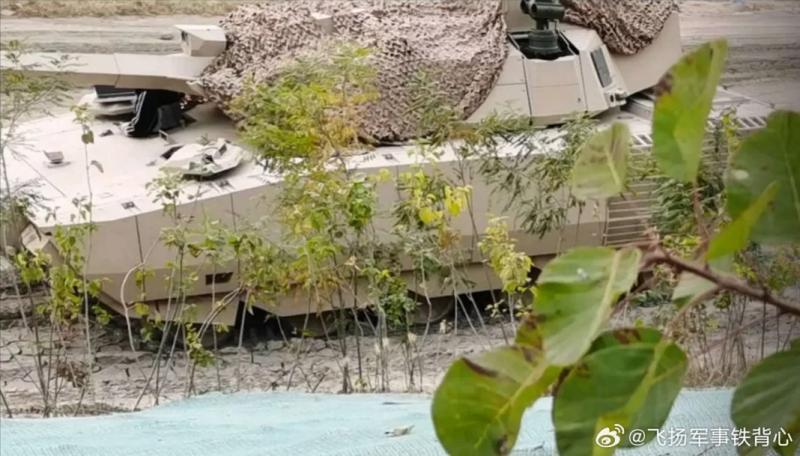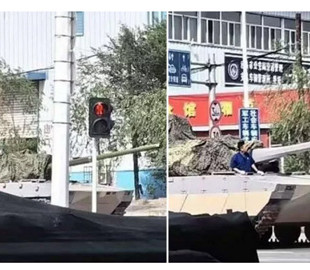
In Chinese social networks, there have been reports of two variants of the new tank spotted in Baotou, China. Vehicles photographed while moving under their own power have generated considerable interest and speculation among military analysts and enthusiasts. Tanks covered with camouflage nets were spotted in the urban area, possibly heading to the training ground, which suggests that the motor part of their development is already quite advanced.
The new prototype tanks are believed to belong to the class of light tanks, as evidenced by their narrow track and similarity to the components of the production tank Type 15 (ZTQ-15), which weighs between 33 and 36 tons. Its weight can be compared with Soviet tanks, such as the T-64 medium tank. Visual similarities to the turret on the test bench and renderings of the earlier tank design, with crew quarters in the hull and an empty turret, further hint at the origin of the prototypes.
These characteristics are consistent with China's recent trend of developing lighter alternatives to main battle tanks such as the ZTZ-99. In addition, the turret test stand was also on display at the Baotou Proving Ground, where Norinco, a leading defense equipment manufacturer in China, recently tested a new heavy infantry fighting vehicle (HIFV) based on the Type 59 main battle tank.
Cross-referencing various Open Source Intelligence (OSINT) sources, including Chinese sources, gives a clearer picture of these new light tanks. The main difference between the two variants is their armament, with speculation pointing to different caliber guns, likely 105mm and 125mm. Both tanks are said to be equipped with active protection systems (APS) that provide 360-degree coverage, including the top, and have thermal shrouds on the gun barrels to reduce heat signatures.
In addition, the tanks are expected to have an electric auxiliary power unit (APU) for silent assaults, a millimeter-range phased-array radar, light detection and ranging (Lidar) sensors, light armor and artillery, an autopilot system, and AI for an automated system definition of goals. They are also integrated into a comprehensive information management system on the battlefield.
Further images of the prototypes show a six-wheeled configuration and narrow tracks, reinforcing the perception of a lighter tank compared to traditional main battle tanks. Modular tank overlays can include dynamic protection units and anti-cumulative grills in the rear. The presence of two forward hatches suggests that a crew of two mans an unmanned turret supported by rotary mortar mounts and several unknown sensors around the turret. This configuration resembles certain characteristics of the new PLZ-05B 155-mm self-propelled howitzer.

Tanks covered with camouflage nets were seen in the urban area, perhaps they were on their way to the training ground, which suggests that the motor part of their development is already quite advanced
In January 2023, images appeared of a test platform based on a Type 15 light tank chassis with an unmanned turret undergoing active defense system testing. By April 2023, Norinco released official concept trailers depicting the upcoming main battle tanks, highlighting features such as invisible gun barrels and modular components. Chief engineer Mao Ming of the Beijing Institute of Technology suggested in a 2023 interview that China's fourth-generation main battle tank would have a lightweight design, a crew of two, and an unmanned turret with a combat weight of about 40 tons. These tanks are expected to have electromagnetic armor, active defense systems, vehicle-mounted drones, and capabilities for integrated day and night operations.
The modular design allows different configurations: 30 ton light version, 40 ton standard version and 50 ton heavy version. To ease the physical strain on the crew, exoskeletons may be provided. Defense systems are expected to incorporate a combination of electromagnetic and reactive armor technologies, enhancing both passive and active protection.
At the time, the media reported that China's fourth-generation main battle tanks could have highly informative fire control and data communication systems that would allow two-man crews to perform tasks normally performed by multiple crew members. These technological advances represent significant changes in battlefield information management and effectiveness. Tanks are expected to have active defense systems capable of intercepting various projectiles, eliminating vulnerabilities such as attacks from above. These systems will likely include millimeter-range radar to detect approaching threats and vehicle-mounted bombs to neutralize them. The fourth-generation main battle tank is expected to have enhanced defensive and offensive capabilities, increasing battlefield survivability.

Images of the prototypes show a potential active protection system (APS) that provides 360-degree coverage, including a top, dynamic armor (ERA), anti-missile arrays, and thermal shrouds on weapon barrels to reduce heat signatures.
< p>

As such, this new light tank, potentially based on the Advanced Armored Assault System (FAAS), could represent a significant advance in Chinese armor technology, which is similar to Russia's Armata platform. If current test reports are accurate, serial production could begin soon, potentially providing the People's Liberation Army with new equipment advantages and complementing the brand new Type 19 8×8 infantry fighting vehicle (IPV). These events indicate a new stage in the development of China's military potential.
China's fourth-generation tanks, with a controlled displacement of around 40 tons, aim to provide performance and range advantages over traditional 60-ton tanks. They represent an evolution in technology and design, including advanced armor systems, improved mobility and increased firepower. These tanks are equipped with active protection systems (APS) designed to intercept incoming projectiles, unmanned turrets to increase crew safety, and sophisticated targeting systems to improve situational awareness and accuracy. Designed for network warfare, these tanks provide better communication and coordination on the battlefield. Modular armor makes it easy to upgrade and customize protection levels, and improved stealth capabilities reduce the likelihood of detection by enemy forces.
Examples of fourth-generation tanks to date include:
- Russian T-14 Armata, which has an unmanned turret and advanced reservation systems;
- the German KF-51 Panther, known for its 130 mm smoothbore gun and advanced situational awareness systems;
- the Japanese Type 10, which emphasizes focus on mobility, modular armor and complex electronic systems.
Additional tanks in this category are the South Korean K2 Black Panther, the Turkish Altay, the American AbramsX, the Franco-German Main Ground Combat System (MGCS), the Indian Future Main Battle Tank (FMBT) and the British Challenger 3.3.

